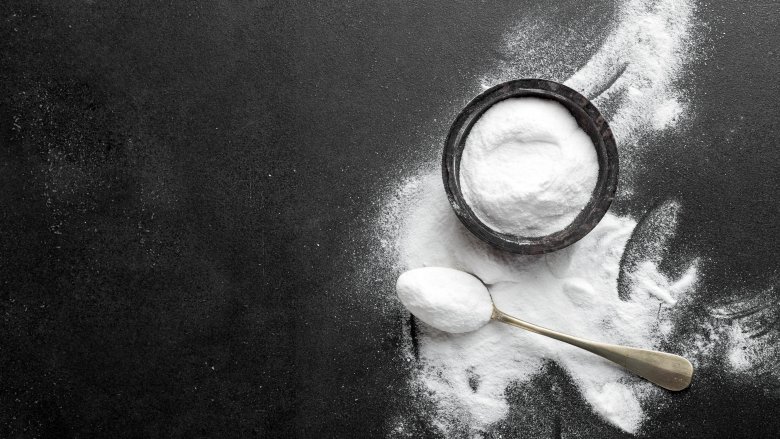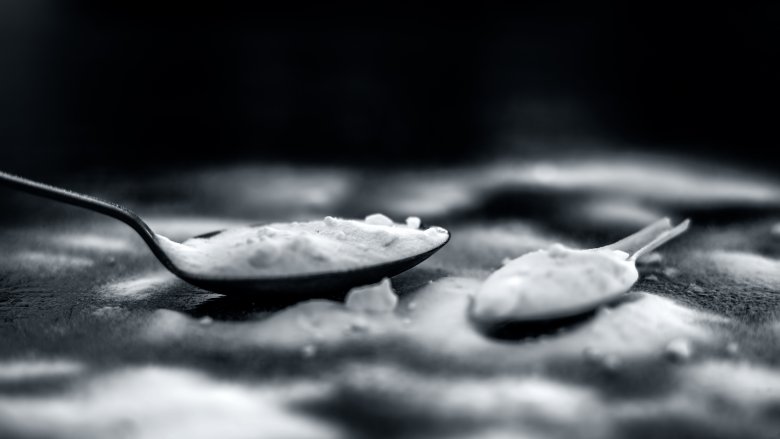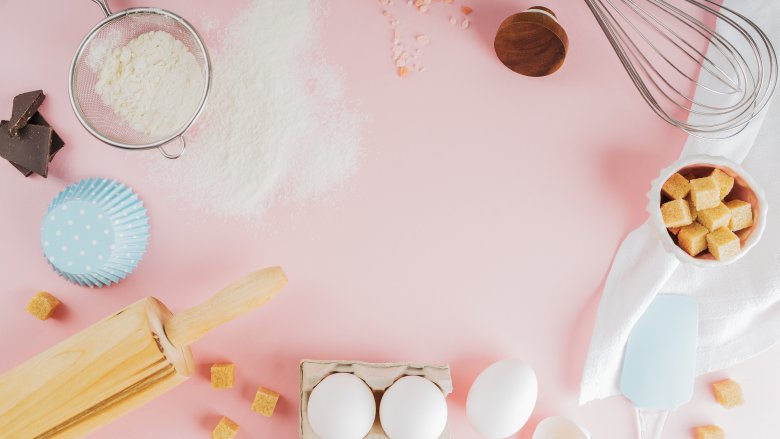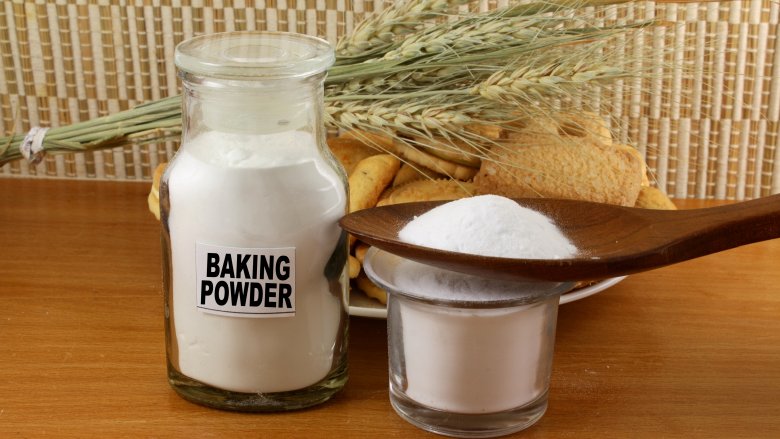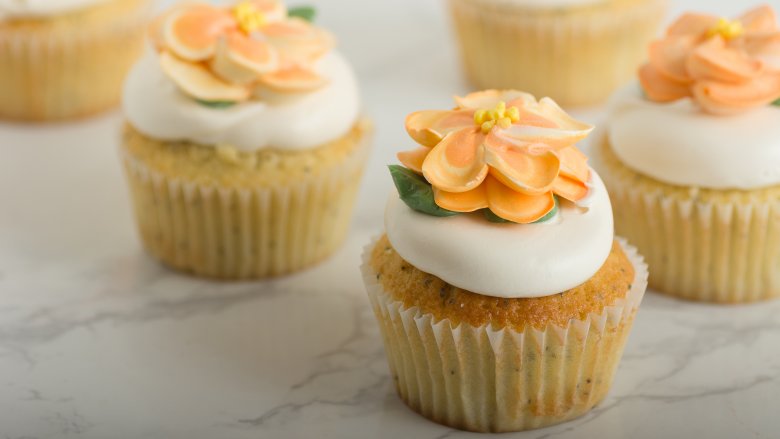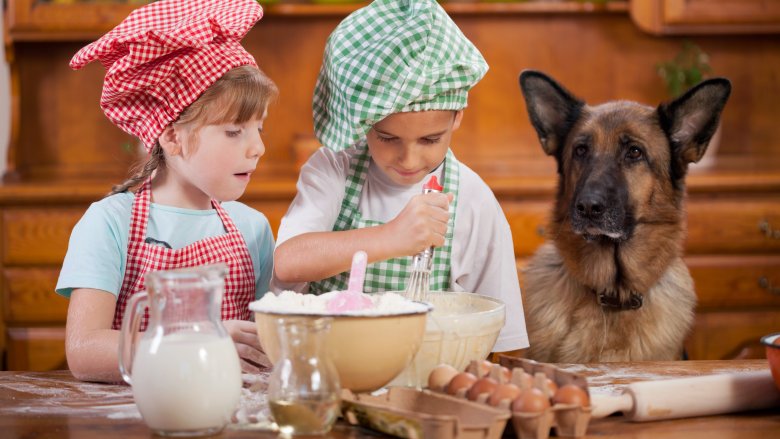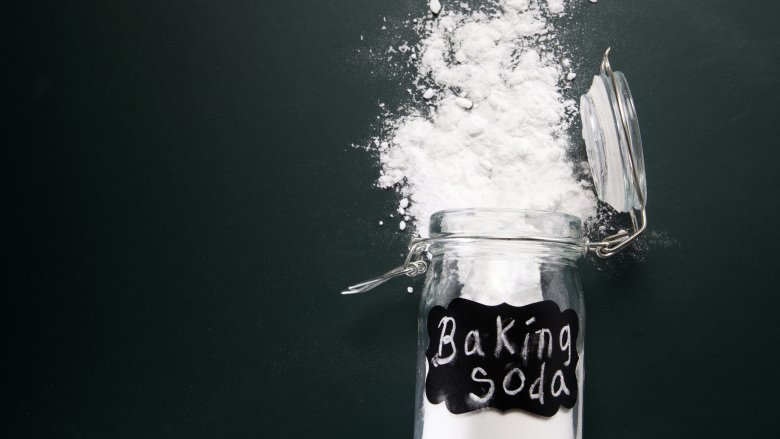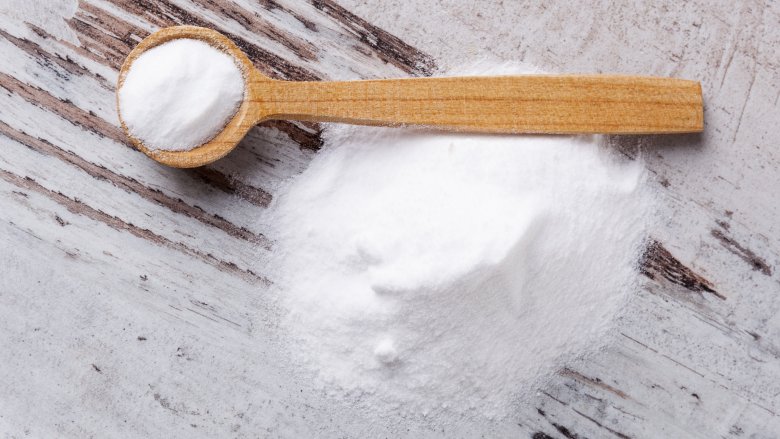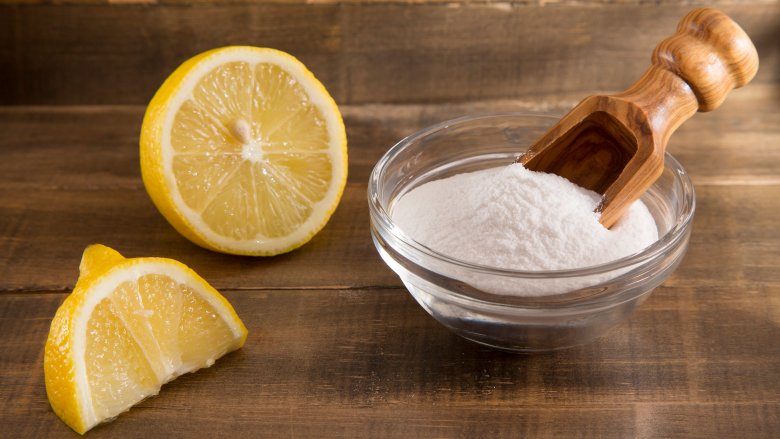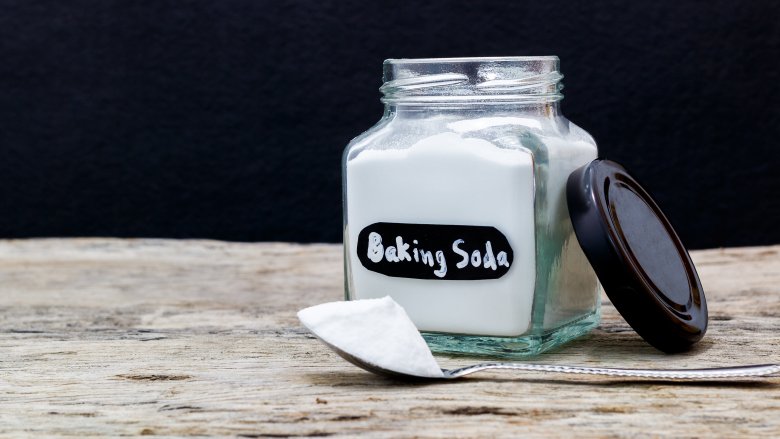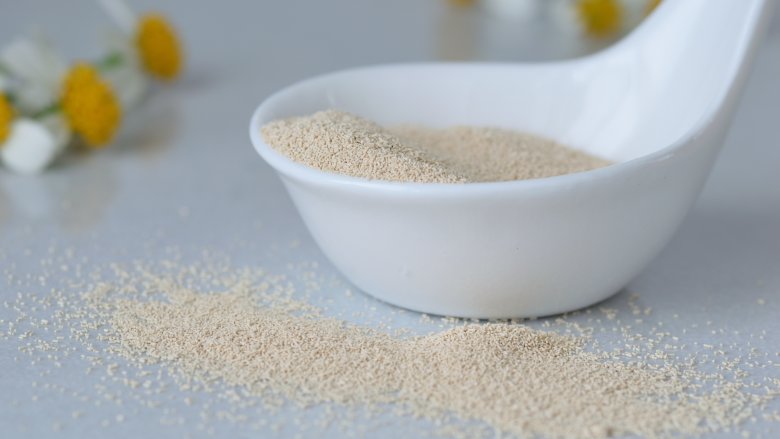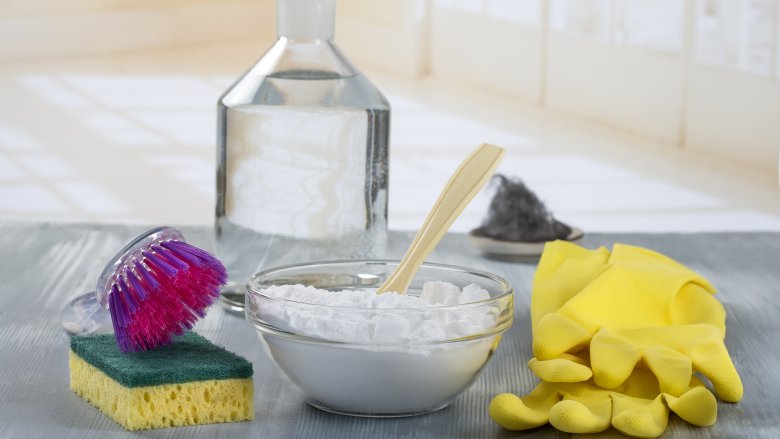The Real Difference Between Baking Soda And Baking Powder
Everyone who bakes has been there, reading a recipe that calls for either baking soda or baking powder, then reaching for the wrong one. Or — worse! — realizing you're out of the one that it calls for. Does it really matter? What's the difference, anyway? They do the same thing... right?
Sort of. The saying goes that baking is a science, and it's completely true. A good recipe is balanced to have the exact quantities of ingredients doing the jobs that need to be done, all so you can get the perfect loaf of bread or gaggle of cupcakes. (That's what they're called, right? A gaggle?) If you throw any of that off, your project isn't going to come out right. And when it comes to baking soda and baking powder, well, there is a difference and it's super important.
So let's not just talk about the difference between the two ingredients, but why it matters. Then, the next time you reach for one, the other, or both, you'll be prepared.
What is baking soda, and what is baking powder?
Let's take your container of baking soda, your container of baking powder, put them on the counter, and take a look at exactly what's inside.
First, baking soda. That's actually straight sodium bicarbonate, and here's a bit of a flashback to grade school science for you. Baking soda is a base, and that means it reacts when it comes in contact with an acid. When you're baking, that can be in the form of a liquid — typically something like lemon, buttermilk, or coffee — or a solid, like brown sugar. Once the two are mixed, they'll form carbon dioxide bubbles and raise the pH of your dough. What does that mean? Basically, those bubbles make your baked goods rise, and increased pH weakens the gluten to make your final product more tender.
Now, baking powder. That's a little different, because that's actually baking soda plus some other ingredients — usually, says Bob's Red Mill, cornstarch and cream of tartar. It contains two acids (which can vary), and it's only when a liquid is introduced that the first acid reacts with the base. Then, once it's exposed to heat, the second reaction happens. But wait, you're saying... If it contains both an acid and a base, wouldn't it automatically react? No, and Healthline says that's where the cornstarch comes in. That acts to keep the reaction from happening until you want it to.
Why recipes call for baking soda, baking powder, or both
If you've ever wondered why a recipe calls for one and not the other — or for both — you're not alone. It's not arbitrary, either.
Since baking soda requires an acid to activate it, Healthline says the only time you're going to see it used is when there's an acid in the recipe. Makes sense, right? If there's no acids in the recipe, you'll use baking powder, since it already contains everything it needs to work.
According to Fine Cooking, there's a little more to it, too. Because baking powder reacts in stages — including one that's activated by the presence of heat — it's going to be used in recipes where the dough needs to either chill or rise. Think of the cookie dough you put in the fridge for a bit before baking, or of bread that needs a long time to rise.
So, why would you need both? Baking soda isn't just activated by the presence of an acid, it also neutralizes it as part of the process. If your recipe contains an acid, it will also call for a certain amount of baking soda to react with and essentially, in the proper proportions, they'll offset each other. But sometimes, that's not enough to get the rise you're looking for. In that case, the recipe will tell you to add a little baking powder to get the extra kick you need.
Wait, there are different kinds of baking powder?
Because things aren't complicated enough when you're just looking at baking powder and baking soda, you'll also need to know that yes, there are different kinds of baking powder, too. Which one you buy makes a big difference, says Fine Cooking.
First, let's take fast-acting baking powder. Here, the reaction is going to happen at room temperature, so as soon as you mix your ingredients, the magic is going to start to happen. You don't always want that, though, so that's where slow-acting baking powder comes in. There's a delay on this one, and it's not going to start doing its thing until it hits a certain temperature. Then, there's double-acting baking powder, which means part is going to happen when you're still at room temperature, and it'll continue while it's in the oven.
If your box of baking powder doesn't say which it is, it's probably double-acting. The other two are mostly used by commercial and professional bakers, and if you picked up your baking powder at the grocery store, you're probably safe in assuming it's the double-acting stuff.
How baking soda and baking powder impact flavor and browning
The taste of both baking soda and baking powder is unmistakable, and in spite of looking very similar and playing the same role in a recipe, Fine Cooking says they do impact the flavor and color of the final product in different ways — and how it works is another reason a recipe might call for both.
Let's use lemon cupcakes as our example. Lemon is an acid, so the recipe is going to call for baking soda to offset some of the acidity and to make those cupcakes rise. But you also want some of that lemon flavor to stay, and in order for that to happen, the baking soda can't use up all of your lemon juice. Add baking powder to the recipe, and you're also adding more acid — and that means you'll have more of that lemon flavor left after the reactions and the rising happens.
But, say you're making lemon pancakes, and you want not just lemon flavor, but those delicious browned edges, too. If you have too much acid in your recipe, that browning isn't going to happen. Baking soda takes away the acid and encourages the browning.
In other words, if you only use baking soda, your tangy lemon recipes would lose their lemon flavor. If you only used baking powder, you wouldn't get that browning reaction. Use both? Perfection.
Why baking soda is a rush, and baking powder isn't
So, you're getting ready to bake, and you're trying to decide if you wake the dog up now to take her outside before you start, or if you let her sleep and just step away from what you're doing mid-recipe. Here's how you decide.
If the recipe calls for baking soda, you'd better take the dog out before you start. That's because the reaction that causes your cake or bread to rise is going to start as soon as you introduce the baking soda to the liquid, and that means you'll have to have the oven pre-heated and get your dough or batter in as soon as you possibly can. If you wait — and, say, step away to run the dog outside — all the carbon dioxide bubbles that are going to make your recipe rise will be gone by the time you get back, and what comes out of the oven will be very, very flat.
On the other hand, if the recipe calls for just baking powder, you'll have time to step away and run the pupper outside if she needs to go. That's because while some of the reaction of double-acting baking powder does, indeed, happen when you first mix them, the majority of the gas doesn't get released until it's in the oven (via ThoughtCo.). And that means your cake will still rise, and you won't have to wake the dog up before you start.
A little goes a long way... with baking soda
Have you ever paid attention to how much baking soda or baking powder a recipe calls for? If you haven't, you might not have realized that most recipes will only call for a relatively small amount of baking soda. And that's super important, because according to Bob's Red Mill, baking soda is about four times stronger than baking powder.
But here's the thing: If you want more rise, you can't just add more baking soda. That's because baking soda will only react in the presence of an acid, and good recipes will include just enough baking soda to react with the right amount of acid. Sally's Baking Addiction notes that if you add more baking soda, it'll run out of acid to interact with and it'll remain inert. And that means you'll just have some leftover baking soda in your cake or bread, and you'll be able to taste it. If you've ever baked something that's had a weird sort of taste — think of what it would taste like if you licked a bar of soap that was filled with flakes of aluminum foil — that's because you had too much baking soda.
And that's why many recipes follow this rule of thumb: For each cup of flour, you'll need a teaspoon of baking powder and only a quarter-teaspoon of baking soda.
How you substitute baking soda for baking powder, and vice versa
Uh oh! You've already started baking, but you forgot to do a cursory glance through your cabinets to make sure you have everything you need and you're out of either baking powder or baking soda. First, the good news: If you have one, you can substitute for the other.
Let's say you're out of baking powder. Since you now know that baking powder is essentially baking soda with the acid already added, you know you can make your own. According to ThoughtCo., it's easy: Just use 1 teaspoon of baking soda and add 2 teaspoons of cream of tartar. Presto! (And yes, you still use the same exact amount of your homemade baking powder as you would use of the commercial stuff.)
If you're out of baking soda, it gets a little trickier. There's baking soda in your baking powder, so you could use three times the baking powder to replace the baking soda. (i.e., use 3 teaspoons to replace 1 teaspoon of baking soda.) But here, there's a catch: The baking powder will change the taste of what you're making, because of those extra ingredients in it. Does it matter to you? If it does, you might want to put your baking on hold and run to the store.
How to make sure your baking soda and baking powder are still good
If you haven't used them in a while, you might wonder whether or not your baking soda and baking powder are any good. Over time, they're not going to spoil, but they will lose some of their reactivity and they're not going to work as well. Fortunately, ThoughtCo. says you can definitely check to see if they're going to work as well as you want them to.
First, baking soda. All you'll need to do is scoop out a quarter teaspoon or so, put it on a plate, and add a few droplets of either lemon juice of vinegar. If you get a lot of bubbles, it's fine.
Then, baking soda. Fill a 1-cup measuring cup a third of the way with hot water, and add a teaspoon of your questionable baking powder. Does it bubble? Yes? It's still good.
Now, if you're wondering at what point you need to worry about whether or not you'll need to be concerned about the freshness of your baking soda and baking powder, keep this in mind: Though they both typically last for six months to one year, the more humid your climate, the faster both will start to lose their fizz.
What happens to baking soda and baking powder at high altitudes?
According to the Science of Cooking, altitude changes how well your baked goods rise — especially once you get above the threshold of 3,000 to 3,500 feet above sea level. The higher you are, the lower your air pressure is, and the lower your air pressure, the better your cakes and breads are going to rise. They're also going to dry out faster, and there's a good chance a recipe meant for lower elevations is going to cause a reaction — and large air bubbles — so big they're going to burst and your cake will collapse.
Can you adjust your baking soda and baking powder to help? Kind of. Some places suggest decreasing both by somewhere between an eighth and a half a teaspoon for each teaspoon a recipe calls for... but that's inexact.
King Arthur Flour suggests something a little different. They say your best bet is if a recipe calls for a teaspoon of either baking soda or baking powder, reduce that to 7/8 if you're between 3,000 and 5,000 feet, to 1/2 if you're between 5,000 and 6,500 feet, and a 1/4 if you're between 6,500 to 8,000 feet. That's if you're using one or the other, but what about a recipe that calls for both?
Then, they say, your best bet is to opt instead for using baking powder and sweet milk. Sometimes, the best thing to do is avoid the problem.
Wait, doesn't yeast do the same thing as baking soda and baking powder?
Baking soda and baking powder are commonly confused, but isn't there one other ingredient that does pretty much the same thing? Yes — it's yeast. So... what's the difference there?
It's all in the reactions. While baking soda and baking powder react with acids and liquids, respectively, yeast reacts with sugars. According to Refinery29, it's an entirely different process that happens with yeast, and that's fermentation. (And that's why yeast isn't as interchangeable with baking soda and baking powder.) When yeast ferments, it's an even slower process — that's why you need to let bread dough sit for a while before popping it in the oven.
There's another way to look at the differences, too. When it comes to baking soda and baking powder, Bob's Red Mill says the reaction that happens is a chemical one. When it comes to yeast, that's a biological reaction. It's a difference that ends up causing the same basic result, but you have to admit it's pretty cool and an excellent fun fact to bring up at parties over a few cookies or slices of cake.
Baking soda has different non-baking uses
When you think of baking soda and baking powder, you probably think of baking. It's right in the name, after all. But there's plenty of things you can do with one of them, and this? This is important.
According to First For Women, baking powder is pretty much only — and best — used for baking. That's it! Baking soda, on the other hand, has a ton of other uses. Healthline says that baking soda had been shown to have some interesting effects when taken as a supplement, and it's been found to help reduce fatigue — especially when you're going through some hardcore exercising sessions, if you're weight training, or participating in high-energy sports like kickboxing or martial arts. It's also been shown to help remove plaque, reduce heartburn, slow the progression of kidney disease, and even relieve the itchiness of bug bites when mixed with water and turned into a paste.
Healthline also says you can use baking soda as a deodorant, a mouthwash, to relieve the pain of canker sores, as an air, garbage can, shoe, and refrigerator freshener, stain remover and laundry whitener, and even as a weed killer. That all makes baking powder look positively boring by comparison, so if you're wondering which one to get the big box of, there's your answer.
